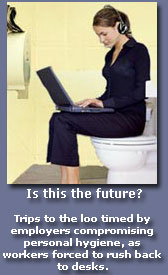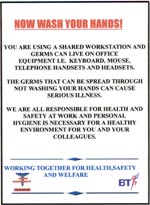Office Workstations Pose Alarming Health Risks As Poor Hygiene Becomes The Norm
The issue of workplace hygiene is a theme that should not be ignored because of the fact that bacteria such as MRSA, e.coli, coliforms, staphylococcus aureus and enterobacteria; may well be present on office equipment and workstations if individuals using them do not ensure best practice when it comes to personal hygiene and equipment cleanliness.
 Given that too many office workers eat and drink at their desks instead of taking the appropriate meal breaks, bacteria from foodstuff accumulates in the keyboard. Dust gathers also, adding to the levels of bacteria.
Given that too many office workers eat and drink at their desks instead of taking the appropriate meal breaks, bacteria from foodstuff accumulates in the keyboard. Dust gathers also, adding to the levels of bacteria.
Whilst this was never better exposed than via two studies undertaken in 2008, one major and one limited to Which? London based offices, a more recent small study, reported earlier last month and undertaken by Initial showed offices are becoming even more unhygienic.
The firm said tests showed computer mice were the filthiest part of workers' desks, containing more than three times the levels of bacteria-related contamination than on the average toilet seat. Computer keyboards were the second most unhygienic piece of office equipment, said Initial Washroom Hygiene, which carried out tests on over 150 separate items in 40 different workstations in a number of offices.
Male workers were found to have dirtier workstations.
Peter Barratt, technical manager at Initial Hygiene, said:
"It is now common for office workers to spend their lunch hour eating at their desk, often surfing the web or continuing to type at the same time. This leaves crumbs and other food residue all over the work station, but particularly on mice and keyboards, making them ideal places for bacteria and other micro-organisms to survive and multiply.
In addition, because they are electrical devices, these items aren't cleaned as regularly or as thoroughly as other parts of the office, or even as the desks themselves."
The American study done by the University of Arizona was by far the largest, and was conducted by Dr Charles Gerba, a professor of microbiology at the University.
The study found the average office desktop harboured 400 times more bacteria than the average office toilet seat in research in 2008. They also found that women have three to four times the amount of germs than men around their work area on average. Although we need to remember that the study was done in the USA, and the same may not be the case in the UK.
 Dr. Gerba's studies conducted at the University of Arizona have found that telephones are the most germ-infected objects in usual environment, followed by desktops, water fountain handles, microwave door handles, computer keyboards and mice. (Famously, these studies have found that keyboards generally have 400 times more bacteria than an average toilet seat.)
Dr. Gerba's studies conducted at the University of Arizona have found that telephones are the most germ-infected objects in usual environment, followed by desktops, water fountain handles, microwave door handles, computer keyboards and mice. (Famously, these studies have found that keyboards generally have 400 times more bacteria than an average toilet seat.)
Here are the relative germ densities of frequently touched office equipment cited in the study abstracts:
- Phone: 25,127 germs per square inch
- Desktop surface: 20,961 germs per square inch
- Keyboard: 3,295 germs per square inch
- Mouse: 1,676 germs per square inch
- Fax machine: 301 germs per square inch
- Photo Copy machine: 69 germs per square inch
- Toilet seat: 49 germs per square inch.
The area where you rest your hand on your desk has on average 10 million bacteria, say the researchers.
"For bacteria, a desk is really the laptop of luxury," Dr. Gerba commented in a press release. "They can feast all day from breakfast to lunch and even dinner." Gerba and his researchers found that unless desks were wiped clean with a disinfectant during the day, bacteria levels climbed higher and higher, peaking after lunch.
Shortly after that study was published, consumer group Which? carried out their own study and found that computer keyboards can house more germs than toilet seats.
Tests carried out on equipment in its own London offices in May 2008 showed alarming results. Out of 33 keyboards swabbed, four were regarded as a potential health hazard and one harboured five times more germs than one of the office's toilet seats.
The keyboards were swabbed for food poisoning bugs e.coli, coliforms, staphylococcus aureus and enterobacteria and the results were compared to those found on a lavatory seat and lavatory door handle. One keyboard was so dirty that a microbiologist ordered it to be removed, quarantined and cleaned.
Impetigo is a common, highly infectious skin disease caused by staphylococcus bacteria or more rarely by the streptococcus pyogenes bacteria. The latter which was found to be present in the Which? study. This disease is highly contagious and whilst not life threatening, in severe cases can lead to extended periods of sick leave from work.
Diabetics are more likely to develop impetigo. As with many highly contagious infective conditions: people with a suppressed immune system, for whatever reason, are at a higher risk of developing impetigo.
 Further, those with existing skin conditions are at greater risk of Impetigo along with diabetics. Such individuals in the workplace are put at risk if sharing equipment and finding themselves exposed to the bacteria spread by those with poor personal hygiene. For this reason alone many employers have signage in staff toilet facilities, reminding people to wash their hands after use of the facilities. It also makes perfect sense for peer pressure to be encouraged to ensure people do challenge those who do not do so.
Further, those with existing skin conditions are at greater risk of Impetigo along with diabetics. Such individuals in the workplace are put at risk if sharing equipment and finding themselves exposed to the bacteria spread by those with poor personal hygiene. For this reason alone many employers have signage in staff toilet facilities, reminding people to wash their hands after use of the facilities. It also makes perfect sense for peer pressure to be encouraged to ensure people do challenge those who do not do so.
Which? said one of the causes of dirty keyboards was users eating lunch at their desk, with crumbs encouraging the growth of bacteria. Poor personal hygiene, such as not washing hands after going to the toilet, could also be to blame, it said. "Most people don't give much thought to the grime that builds up on their PC, but if you don't clean your computer, you might as well eat your lunch off a lavatory seat," Which? computing editor Sarah Kidner said.
Which? found that one in ten people never clean their keyboard, while 20 per cent never clean their mouse. Around half cleaned their keyboard less than one a month. These findings are believed to be typical of offices all over Britain, especially with the the modern practice of "hotdesking", in which staff sit at different desks every week, and this means that workers do not know who has been using their keyboard before them.
 The bacteria crawling all over your phone, keyboard, and mouse may include hundreds of different types, including E. coli, Klebsiella pneumonia, streptococcus, salmonella, and staphyloccus aureus (a.k.a. "staph").
The bacteria crawling all over your phone, keyboard, and mouse may include hundreds of different types, including E. coli, Klebsiella pneumonia, streptococcus, salmonella, and staphyloccus aureus (a.k.a. "staph").
Despite the Display Screen Equipment regulations making it clear that users of such equipment are entitled to be given paid time to adjust their workstations, and this would include hygiene measures, to suit the individuals needs; those working in call centres, on shift work, or hot desking; are seldom given the time and are expected to be ready to use their PCs and call equipment immediately upon being on shift.
This makes the risk of harmful bacteria accumulating on keyboards, headsets, handsets, computer mice and work surfaces more likely; and puts individuals at risk of illnesses caused by the bacteria identified in both the Which? study and that of Dr Berga at the University of Arizona.
So next time you go to the toilet - wash your hands!
Source: NHS / Dr Gerba / Charles Moor / University of Arizona / Which? / Intitial Hygiene / Leanne M James